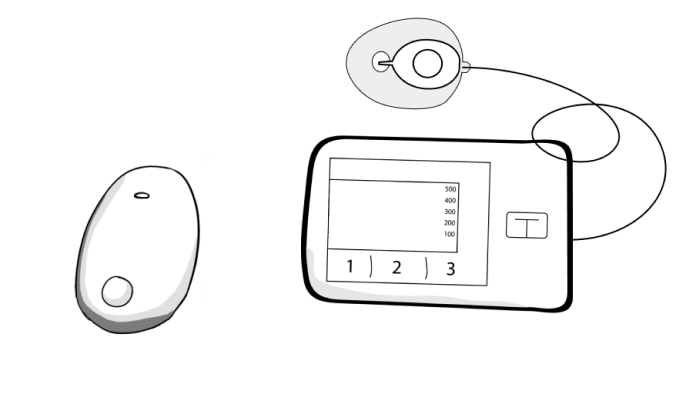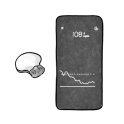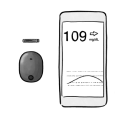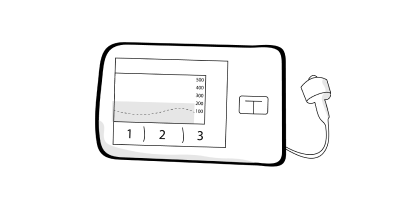Diabetes Device Choices
Overview
Sensor & Injections
Medtronic Sensor & Medtronic InPen

If you don't like having more than one device on your body but want glucose data at a glance, the Medtronic Sensor connects to the Medtronic InPen to track blood sugar and insulin doses on a smartphone.
Sensor & Pump
Eversense & Tandem

The Eversense sensor is implanted under the skin, so you can be discrete when needed. Paired with the Tandem pump, you have the ability to easily dose your insulin as needed. The Tandem pump also allows you to bolus directly from a compatible iOS or Android smartphone.
*You will need an iPhone to use the Eversense sensor.
Priority: Overall
Next Steps

You're going to do great on the devices you choose
Talk to your provider to get a prescription. Advocate for yourself with a list of reasons why you believe it is best for your lifestyle.
Talk to the device companies about the device you want and if your insurance will cover it. They can help with this.
Many insurance companies require documentation of different qualifications before approving diabetes device coverage. every insurance company is different but some common qualifications include checking your blood sugar 4-6 times per day or having frequent low blood sugars. Understanding what qualifications are necessary for device coverage before starting the approval process can make things a lot easier.
Visit https://diabeteswise.org/resources/getting-treatment/qualify-for-insurance/ for more resources.
Questions for your Doctor
Medtronic Sensor & Medtronic InPen
Can I try this before I commit to it?
A lot of provider offices have sample devices you can touch and feel to get a sense of how they work. Some offices even have a trial device you can use for week to see how it works for you.
Eversense & Tandem
Can I try this before I commit to it?
A lot of provider offices have sample devices you can touch and feel to get a sense of how they work. Some offices even have a trial device you can use for week to see how it works for you.
Questions for your insurance
Many insurance companies require documentation of different qualifications before approving diabetes device coverage. Every insurance company is different, but some common qualifications include checking your blood sugar 4-6 times per day or having frequent low blood sugars. Understanding what qualifications are necessary for device coverage before starting the approval process can make things a lot easier.
Talk to the device companies
Guardian Connect
Call Medtronic and ask them about how much it will cost with your insurance coverage. Talk to your Doctor to get a prescription.
1-800-646 4633 Medtronic WebsiteMedtronic InPen
Call Medtronic and ask them about your coverage. Talk to your Doctor to get a prescription.
1-888-350-5440 Medtronic WebsiteEversense
Either call the phone number here to ask about getting started or fill out the form that is linked here to get started.
1-844-736 7348 Eversense WebsiteTandem t:slim X2
Call Tandem and ask them about your coverage. Talk to your Doctor to get a prescription.
1-877-801-6901 Tandem WebsiteAdditional Resources
By Priorities
 Active Lifestyle
Active Lifestyle
 Avoiding Highs and Lows
Avoiding Highs and Lows
 Comfort
Comfort
 Easy Insulin Dosing
Easy Insulin Dosing
 Easy to Use
Easy to Use
 Fewer Fingersticks
Fewer Fingersticks
 Privacy
Privacy
Cost & Coverage
Guardian Connect

Eversense

Glucose Testing Supplies
Sensors
Transmitter
Sensors
Transmitter (1 time purchase & Rechargeable)
Glucose Testing Cost Estimate
Startup $69 to $206
Monthly $32 to $97
These prices vary by Insurance. If you call Medtronic they will start a process to check exactly how much your costs will be. Generally Medtronic pumps and sensors are covered by private insurance and medicare. It may be covered under durable medical goods or a pharmacy benefit.
Startup Bridge Program $99.
This is a trial program and there are eligibility requirements that should be considered prior.
Eversense is covered by select insurers, including Cigna and Medicare.
Medtronic InPen

Tandem t:slim X2

Insulin Dosing Supplies
Pump
Charger
Insulin Cartridges
Infusion Sites
Insulin Dosing Cost Estimate
Monthly $5 to $1260
The total cost depends on the amount of pens you use which is dependent on how much insulin you use.
Startup $5 to $6,995
Monthly $20 to $200



